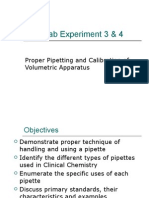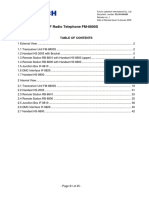Pipette Notes
Pipette Notes
Uploaded by
Abduladzis ManaloCopyright:
Available Formats
Pipette Notes
Pipette Notes
Uploaded by
Abduladzis ManaloOriginal Description:
Original Title
Copyright
Available Formats
Share this document
Did you find this document useful?
Is this content inappropriate?
Copyright:
Available Formats
Pipette Notes
Pipette Notes
Uploaded by
Abduladzis ManaloCopyright:
Available Formats
COMPILED NOTES IN CLINICAL CHEMISTRY Roderick D.
Balce, RMT 1
PIPETTING
1. Types of Pipette According to Calibration
a. TC (To contain) Pipette
▪ holds a particular volume but does not dispense that exact volume
▪ calibrated by introducing the exact weight of mercury required to give the desired volume at a specific
temperature
b. TD (To deliver) Pipette
▪ dispenses the indicated volume
▪ calibrated by weighing the volume of water that will flow from the pipette by gravity
▪ rate of delivery must never be hastened by blowing
▪ when an etched ring is seen near the mouthpiece, remaining drop at the tip after delivery is blown out to
receiving vessel
2. Types of Pipette According to Use
a. Graduated or Measuring Pipettes
▪ deliver an amount of liquid contained between two calibration marks
▪ with larger tolerances than volumetric pipettes
▪ used when great accuracy is not required or when speed is more important than precision
o Serologic
• has calibration marks to the tip
• the rate of fall of liquid is much faster because of a larger orifice
• generally a blow-out pipette (has an etched band on the suction piece)
o Mohr
• calibrated between two marks; no graduation marks to the tip
• self-draining but the tip should not be allowed to touch the vessel wall while draining
o Bacteriologic
o Ball, Kolmer, and Kahn
o Micropipettes
• TC pipettes designed as either Mohr or serologic
• used when small amount of blood or specimen is needed (<1 ml)
b. Volumetric Pipette
▪ has the greatest degree of accuracy and precision and should be used when diluting standards, calibrators
or quality control materials
▪ TD and self-draining pipette designed to dispense one volume without further subdivisions
▪ has a cylindrical bulb midway between the mouthpiece and the tip that decreases surface area/unit volume
and diminishes error from adherent water film
c. Ostwald-Folin Pipette
▪ used with biologic fluids having a viscosity greater than that of water
▪ measures smaller volume (2.0 mL or less)
▪ has a large oval bulb near the tip and an etched mark or ring near the mouthpiece (blow out)
d. Pasteur Pipettes
▪ no calibration marks; used to transfer biologic fluids without consideration of a specific volume
3. Important considerations in manual pipetting
a. Mouth pipetting is not allowed. Use an aspirator bulb or a pipetting pump.
b. Use the top of the meniscus when measuring viscous and colored solutions.
COMPILED NOTES IN CLINICAL CHEMISTRY Roderick D. Balce, RMT 2
c. The tip of the pipette should not be in contact with the accumulating fluid in the receiving vessel during
drainage.
d. Immediately after use, glass pipettes are placed in a cylinder containing water and detergent or a commercial
cleaning solution (sodium hypochlorite), soaked for 30 min, rinsed with tap water 3 times, followed by 1 rinse
with deionized or distilled, and dried in a hot oven (<140 °C).
e. If there is not enough fluid to draw all the way to the final graduation mark, the fluid may be drawn to the
graduation mark of the volume to be transferred.
f. An alternative to wiping the side of the pipette after drawing liquid is allowing the outside of the pipette to
gently touch the inner lip of the original vessel to remove any adherent liquid being careful though to avoid
touching the tip of the pipette and introducing an air bubble.
You might also like
- PipettesDocument47 pagesPipettesJeramie Dean100% (1)
- Is 8897Document32 pagesIs 8897Ayan Naskar100% (1)
- Pipetting NotesDocument2 pagesPipetting NotesRoderick Balce50% (2)
- P I P e Tti N GDocument3 pagesP I P e Tti N GDennis ValdezNo ratings yet
- Activity 2.1 - Manual Pipetting PDFDocument10 pagesActivity 2.1 - Manual Pipetting PDFno veNo ratings yet
- Clinical Chemistry Lab Pipettes and SafetyDocument12 pagesClinical Chemistry Lab Pipettes and SafetyChristine AngNo ratings yet
- Pipetting Handout 09Document9 pagesPipetting Handout 09Irving ParraNo ratings yet
- Appendix I PipettingDocument2 pagesAppendix I PipettingAshleye GramNo ratings yet
- Pipetting TechniqueDocument38 pagesPipetting TechniqueLeo NoquilNo ratings yet
- Instrumentasi & Pengukuran: Pertemuan Ke - 2Document14 pagesInstrumentasi & Pengukuran: Pertemuan Ke - 2ayu nurul mausufyNo ratings yet
- CC1 - InstrumentationDocument21 pagesCC1 - InstrumentationMr. everythingNo ratings yet
- Activity 04Document38 pagesActivity 04Rezzy Mae Panadero OraNo ratings yet
- Pipetting Post LabDocument29 pagesPipetting Post Labrrchard100% (3)
- Volumetric GlasswareDocument17 pagesVolumetric Glasswaremaduche1234No ratings yet
- MLS MLC PIPETTE20-Measurement - of - Volume NJ CB 2024Document30 pagesMLS MLC PIPETTE20-Measurement - of - Volume NJ CB 2024Charles BagendaNo ratings yet
- Using A Burette: Expert Tips For Practical Work 1Document6 pagesUsing A Burette: Expert Tips For Practical Work 1Mohd HanisNo ratings yet
- Calibrationofglassware 120408004156 Phpapp02Document27 pagesCalibrationofglassware 120408004156 Phpapp02Nafees AliNo ratings yet
- Lab InstrumentsDocument19 pagesLab InstrumentsRAVIRAJ NAIK100% (1)
- Chem Micropipette Calibration 2014Document15 pagesChem Micropipette Calibration 2014Elisa PattonNo ratings yet
- Checking The Net Contents of Packaged Goods: The Use of Volumetric Pipets With NIST Handbook 133Document7 pagesChecking The Net Contents of Packaged Goods: The Use of Volumetric Pipets With NIST Handbook 133Akhmad AlbariNo ratings yet
- Lab 02 - Pipetting Technique and Micropipette CalibrationDocument17 pagesLab 02 - Pipetting Technique and Micropipette CalibrationVincent ReyesNo ratings yet
- Chem Note 2Document7 pagesChem Note 2Gee BandongNo ratings yet
- Introduction To Laboratory ApparatusDocument53 pagesIntroduction To Laboratory ApparatusshubheetyagiNo ratings yet
- Tutorial Chapter 2 (CHM421)Document4 pagesTutorial Chapter 2 (CHM421)Shahirah AmiraNo ratings yet
- Drilling Fluid LabDocument28 pagesDrilling Fluid LabOthman ElnadoreyNo ratings yet
- CHEM 334 Quantitative Analysis Laboratory: Calibration of Volumetric GlasswareDocument6 pagesCHEM 334 Quantitative Analysis Laboratory: Calibration of Volumetric Glasswareasjad rajaNo ratings yet
- Acid Neutralizing CapacityDocument6 pagesAcid Neutralizing CapacityFarah IlyaniNo ratings yet
- Laboratory Equipment PDFDocument34 pagesLaboratory Equipment PDFBOB CHESTER DIMASINNo ratings yet
- Tools in AnachemDocument35 pagesTools in AnachemShirl Angelee Ocampo100% (1)
- Pipette Slides-RLD4Document44 pagesPipette Slides-RLD4thasrioNo ratings yet
- Different Types of Orifice PlatesDocument16 pagesDifferent Types of Orifice Platesheament pelodiaNo ratings yet
- Measuring Apparatus For LiquidsDocument14 pagesMeasuring Apparatus For LiquidsWasim AkramNo ratings yet
- 2122 Course Revision Questions Chemistry Level L T1 MSDocument68 pages2122 Course Revision Questions Chemistry Level L T1 MSa.fathiali270310No ratings yet
- Module 2-Basic Laboratory Principles, Techniques and ApparatusDocument5 pagesModule 2-Basic Laboratory Principles, Techniques and ApparatusAllyah Ross DuqueNo ratings yet
- Chapt 1 Micropipette OperationDocument41 pagesChapt 1 Micropipette Operationeden.bgirmaNo ratings yet
- 1 Intro Lab MathDocument6 pages1 Intro Lab MathArielle MarvicNo ratings yet
- Chem Lab Actibity 1 4Document27 pagesChem Lab Actibity 1 4angelineminaNo ratings yet
- A Graduated Pipette Is A Pipette With Its VolumeDocument2 pagesA Graduated Pipette Is A Pipette With Its VolumejhonNo ratings yet
- Drinking Water PurificationDocument102 pagesDrinking Water PurificationRania FitouriNo ratings yet
- Laboratory Practical Pharmaceutical AnalysisDocument11 pagesLaboratory Practical Pharmaceutical Analysisaboelkhair1221No ratings yet
- Chemistry DMCU1233 Lab Tutorial 2019Document43 pagesChemistry DMCU1233 Lab Tutorial 2019HaziminAminNo ratings yet
- Lec5-Calibration of Glasswares and Basic Equipment - POWERPOINTDocument23 pagesLec5-Calibration of Glasswares and Basic Equipment - POWERPOINTAngel Christine Suñiga DesiderioNo ratings yet
- To Contain and To DeliverDocument5 pagesTo Contain and To DeliverMariel AbatayoNo ratings yet
- Chemistry DMCU1233 Lab and Tutorial 2020Document45 pagesChemistry DMCU1233 Lab and Tutorial 2020luqman04hakimiNo ratings yet
- Laboratory (Corrections) Revised 2019 K.MDocument32 pagesLaboratory (Corrections) Revised 2019 K.Mmusiccrazikm .indiaNo ratings yet
- Bresle Chloride Kit: Contamination of Blast-MediaDocument7 pagesBresle Chloride Kit: Contamination of Blast-MediaAlberto Rosa MarNo ratings yet
- PipettingDocument6 pagesPipettingNadiratul KhairahNo ratings yet
- Lab Experiment and Tutorial DMCU1236Document47 pagesLab Experiment and Tutorial DMCU1236akut1234-1No ratings yet
- Important Notes On Ana Chem Lecture 3 (Part 2)Document5 pagesImportant Notes On Ana Chem Lecture 3 (Part 2)Eliza Loren PalleraNo ratings yet
- DACS1232 Lab ExperimentDocument39 pagesDACS1232 Lab ExperimentQielaa MalikNo ratings yet
- 1.04 Experiment 1 Osmosis PreparationDocument2 pages1.04 Experiment 1 Osmosis PreparationDon SunilNo ratings yet
- 1588022427pipettes, Care and UsesDocument15 pages1588022427pipettes, Care and UsesmarvelkuesiriNo ratings yet
- Biology 9 Pipette and Micropipette Use PipettesDocument4 pagesBiology 9 Pipette and Micropipette Use PipettesHi Tech Calibration ServicesNo ratings yet
- English (Pipettes)Document7 pagesEnglish (Pipettes)Catur SriharyonoNo ratings yet
- Mud Kit - Slurry Kit ManualDocument8 pagesMud Kit - Slurry Kit ManualAlok SinghNo ratings yet
- Laboratory Experiment 1 How To Use and Calibrate A MicropipetteDocument4 pagesLaboratory Experiment 1 How To Use and Calibrate A MicropipetteBebelyn SuganobNo ratings yet
- Sop For Using Micro-Pipet in Lab.Document3 pagesSop For Using Micro-Pipet in Lab.Shafquat AasifiNo ratings yet
- CCC Question Answer PDF in EnglishDocument10 pagesCCC Question Answer PDF in Englishrockyya234No ratings yet
- Yy 0 Cimj 7 Aj G68 FN AV2 OJDocument105 pagesYy 0 Cimj 7 Aj G68 FN AV2 OJJosé Manuel Jiménez RodríguezNo ratings yet
- Peripheral Nerve Block (PNB)Document1 pagePeripheral Nerve Block (PNB)ridhoadityaNo ratings yet
- Welding Defects What Is AcceptableDocument4 pagesWelding Defects What Is AcceptablesboergertNo ratings yet
- Notice of ConstructionDocument1 pageNotice of ConstructionJc JüsäyänNo ratings yet
- Fire Drills ProceduresDocument2 pagesFire Drills ProceduresAnumolu Ramakrishna100% (1)
- Intercompany Cross Charges TrainingDocument16 pagesIntercompany Cross Charges TrainingNatasha BhalothiaNo ratings yet
- 026 Republic vs. HidalgoDocument20 pages026 Republic vs. HidalgoRonald MorenoNo ratings yet
- Group 7 RRLDocument5 pagesGroup 7 RRLGrape JuiceNo ratings yet
- The Ladies Garment Worker Volume 2 Issue 5Document26 pagesThe Ladies Garment Worker Volume 2 Issue 5UCOK GGNo ratings yet
- Murdo Coyote, March 28, 2013Document10 pagesMurdo Coyote, March 28, 2013surfnewmediaNo ratings yet
- The Acquisition ProcessDocument3 pagesThe Acquisition ProcessYuriUstinov100% (1)
- TAB Whitepaper R9Document45 pagesTAB Whitepaper R9Nilanjan RoyNo ratings yet
- VHF Radio Telephone FM 8800s Furuno Labotech PDFDocument109 pagesVHF Radio Telephone FM 8800s Furuno Labotech PDFRafaelNo ratings yet
- Biological ModelDocument10 pagesBiological ModelHoney-Zeth TalaveraNo ratings yet
- Miranda V CADocument12 pagesMiranda V CAGertrude ArquilloNo ratings yet
- 2023 GMN NV Arr Manchon TibaoDocument4 pages2023 GMN NV Arr Manchon Tibaokader.guemaounNo ratings yet
- Conductors and Insulators Phet WorksheetDocument2 pagesConductors and Insulators Phet WorksheetHeri E. Asysyakiri0% (1)
- 8.3-Key Technologies and Case Analysis of Floating PV 20220801Document33 pages8.3-Key Technologies and Case Analysis of Floating PV 20220801Moh. Faruoq FaradastNo ratings yet
- Marketing Report On Yellow by BeximcoDocument36 pagesMarketing Report On Yellow by BeximcoAhamed Najeeb Rahman75% (4)
- Art Collectoions 2021Document32 pagesArt Collectoions 2021HermanNo ratings yet
- RRB Cwe Off Scale II IIIDocument10 pagesRRB Cwe Off Scale II IIIramarao_pandNo ratings yet
- FT 70DRDocument40 pagesFT 70DRCamoColtonNo ratings yet
- 64th EC MeetingDocument16 pages64th EC MeetingBalajiKothandanNo ratings yet
- Display 05122017Document65 pagesDisplay 05122017NDTV80% (5)
- Niengo Outsep North Papua 5 - 06 - 07rev2Document20 pagesNiengo Outsep North Papua 5 - 06 - 07rev2Prince DenhaagNo ratings yet
- Querying Using SELECT - Installation InstructionsDocument21 pagesQuerying Using SELECT - Installation Instructionsriteshjain12345No ratings yet
- Chapter 13: Equity and Fairness in Reward ManagementDocument6 pagesChapter 13: Equity and Fairness in Reward ManagementhehehuhuNo ratings yet
- Makila 1: Safran Helicopter EnginesDocument6 pagesMakila 1: Safran Helicopter EnginesJavier CastroNo ratings yet
- Economics 212 Principles of Macroeconomics Study GuideDocument12 pagesEconomics 212 Principles of Macroeconomics Study GuideDuc PhamNo ratings yet

























































































